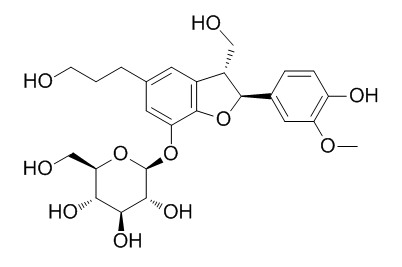Providing storage is as stated on the product vial and the vial is kept tightly sealed, the product can be stored for up to
24 months(2-8C).
Wherever possible, you should prepare and use solutions on the same day. However, if you need to make up stock solutions in advance, we recommend that you store the solution as aliquots in tightly sealed vials at -20C. Generally, these will be useable for up to two weeks. Before use, and prior to opening the vial we recommend that you allow your product to equilibrate to room temperature for at least 1 hour.
Need more advice on solubility, usage and handling? Please email to: service@chemfaces.com
The packaging of the product may have turned upside down during transportation, resulting in the natural compounds adhering to the neck or cap of the vial. take the vial out of its packaging and gently shake to let the compounds fall to the bottom of the vial. for liquid products, centrifuge at 200-500 RPM to gather the liquid at the bottom of the vial. try to avoid loss or contamination during handling.
Chem Pharm Bull (Tokyo). 1995 Dec;43(12):2187-94.
Studies on the constituents of Clematis species. VI. The constituents of Clematis stans Sieb. et Zucc.[Pubmed:
8582022]
METHODS AND RESULTS:
From the roots of Clematis stans three new oleanane-type triterpenoid saponins named clemastanoside A, B and C, and two new lignan glycosides named Clemastanin A and B, have been isolated together with three known triterpenoid saponins, huzhangoside B, C and D, and three known lignan glycosides, (+)-lariciresinol 4-O-beta-D-glucopyranoside, (+)-lariciresinol 4'-O-beta-D-glucopyranoside and (+)-pinoresinol 4,4'-O-bis-beta-D-glucopyranoside. In addition, from the leaves, four new oleanane-type triterpenoid saponins, named clemastanoside D, E, F and G, have been isolated together with five known triterpenoid saponins, hederasaponin B, kizutasaponin K12, huzhangoside B, sieboldianoside B and huzhangoside D, and three known flavonoids, isoquercitrin, rutin and quercetin 3-O-beta-D-glucuronopyranoside.
CONCLUSIONS:
The structures of the new compounds were elucidated based on chemical and physicochemical evidence as follows: clemastanoside A, 3-O-beta-D-ribopyranosyl-(1-->3)-alpha-L-rhamnopyranosyl-(1-->2)-a lpha-L- arabinopyranosyl oleanolic acid 28-O-(4-O-acetyl)-alpha-L-rhamnopyranosyl-(1-->4)-beta-D- glucopyranosyl-(1-->6)-beta-D-glucopyranosyl ester (terminal rhamnosyl 4-O-acetate of huzhangoside B); clemastanoside B and C, 3-O-beta-D-xylopyranosyl- and 3-O-beta-D-ribopyranosyl-(1-->3)-alpha-L- rhamnopyranosyl-(1-->2)-beta-D-galactopyranosyl oleanolic acid 28-O-alpha-L-rhamnopyranosyl-(1-->4)-beta-D-glucopyranosyl- (1-->6)-beta-D-glucopyranosyl ester, respectively; clemastanoside D, 3-O-beta-D-ribopyranosyl-(1-->3)-alpha-L-rhamnopyranosyl- (1-->2)-alpha-L-arabinopyranosyl hederagenin 28-O-beta-D-glucopyranosyl ester; clemastanoside E, F and G, terminal rhamnosyl 4-O-, 3-O- and 2-O-acetate of 3-O-beta-D-ribopyranosyl-(1-->3)-alpha-L-rhamnopyranosyl-(1-->2)-a lpha-L- arabinopyranosyl hederagenin 28-O-alpha-L-rhamnopyranosyl-(1-->4)-beta-D-glucopyranosyl-(1-->6)-beta- D- glucopyranosyl ester, respectively; Clemastanin A, (7S,8R)-3-methoxy-3',4,9,9'-tetrahydroxy-4',7-epoxy-5',8-lignan 3'-O-beta-D-glucopyranoside; clemastanin B, (+)-lariciresinol 4,4'-O-bis-beta-D-glucopyranoside.



